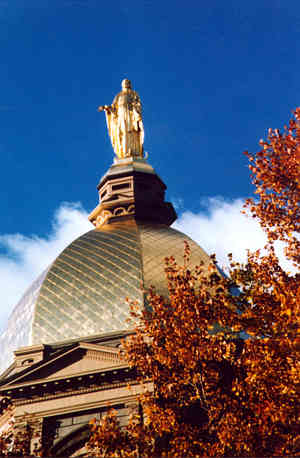
Mary and the School Colors
In an 1890s folder in the University Archives which contained descriptions of the University from earliest times, I found this interesting item from an article written by Lelia P. Roby in 1891.
It is interesting to know that the college colors are yellow and blue; in heraldry, yellow is light and blue is truth.(197)
The extent of the University’s devotion to Mary hadn’t fully registered on me until I also read these words in an 1896 Annals:
Notre Dame the Home of the “Ave Maria,” Notre Dame the home of Mary to whom all the grounds are dedicated, to whom all the buildings are dedicated, to whom is given all the credit of the work done here for the past fifty years. Mary is sole superior at Notre Dame.(198)
The Ave Maria put it even more succinctly: “Every inch of its ground was consecrated to Mary.”
It hadn’t occurred to me before, that even the school colors for both campuses were chosen to honor Mary.
I’ve never seen this reference to the significance of the symbolism of the school colors in any other printed source before or since. I had a feeling at the time that it might factor into my later research, so I set it aside and decided to wonder about it later. Now seemed as good a time as any to check it out. A reference book on symbolism at the St. Joseph County Public Library revealed more interesting information on the subject. A call to Saint Mary’s revealed that their colors were the traditional ones associated with Our Lady -- sky blue and white. It was evident that all aspects of both campuses were related to Marian devotion and the inspiration to be derived from her heavenly protection.
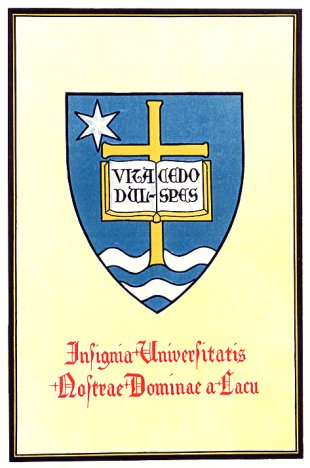
When I inquired about the school colors at the archives on both campuses, I was surprised to learn little was known about their meaning, other than the obvious, that Our Lady’s colors were blue and white. Their original symbolism was apparently lost in history along with this early 1890s reference to the school colors. Following is the information I found regarding the school colors chosen to represent Notre Dame and Saint Mary’s. It is interesting to note that all the attributes listed with these colors are also associated with Mary:
BLUE Truth; the Intellect; revelation; wisdom; loyalty; fidelity; constancy; chastity, chaste affections; spotless reputation; magnanimity; prudence; piety; peace; contemplation; coolness. . . . Christian: Heaven; heavenly truth; eternity; faith; fidelity; the colour of the Virgin Mary as Queen of Heaven.
GOLD -- The sun; divine power; the splendour of enlightenment; immortality. . . .
WHITE . . . White is associated with both life and love, death and burial. In marriage it symbolizes death to the old life and birth to the new, while in death it represents birth into the new life beyond. . . . The purified soul; joy; purity; virginity, innocence; the holy life; light; integrity.
YELLOW Christian: As golden sacredness; divinity; revealed truth; ‘the robe of glory’ used for feasts of Confessors.(199)
Notre Dame’s Blue and Yellow (or gold), its Golden Dome, and Saint Mary’s Blue and White are emblematic of everything Our Lady represents. Sometime, undoubtedly after the Dome and Statue were gilded, Notre Dame’s colors, Blue and Yellow, must have become Blue and Gold. The first evidence of this turned up in an account of a pilgrimage to the Grotto in 1896 and the badges that were worn. “The badge was a circle with a picture of the Grotto, suspended from a blue and gold ribbon hanging from a gilt bar. It was pretty.”
In February, 1931 an article appeared in The Notre Dame Alumnus describing Notre Dame’s New Coat of Arms:Heraldry as an art is almost as old as the recorded history of the human race. References to symbols representing an individual or a family can be found in the Old Testament, in the classic poetry of Greece and Rome, in the unlettered traditions of primitive races. It was during the Middle Ages, however, particularly during the Crusades when all Christendom united to reclaim the Near East, that heraldry developed from a crude art to a mature expression of family and institutional ideals and traditions. The study of medieval heraldry is a fascinating though complex science. Ecclesiastical heraldry, almost as old as the Church, is more or less closely related to the liturgy of the church. It is entirely appropriate that the University of Notre Dame should have and use an authentic coat-of-arms symbolic of her history, traditions, and ideals.
The colors blue and gold [or gold and blue] are the colors of the Virgin to whom Notre Dame (her very name) is dedicated. There are various heraldic emblems symbolic of the Virgin Mother of God in addition to the colors blue and gold (or as heraldry has it, azure and gules). Since the official title of the University is “Universitas Dominae Nostrae a Lacu” (by the lake), the star, reminiscent of the beautiful epithet Star of the Sea, was chosen as Mary’s symbol in the new shield of arms. At the Base of the shield are two wavy broad lines of silver, always used in heraldry to represent water, here used to express “a Lacu” of Notre Dame’s name. Thus the star and the waves of silver become poetically expressive of the dedication of the University to the Star of the Sea.
The Cross represents the Congregation of Holy Cross, whose members founded and still administer the University. The open book is always emblematic of an institution of learning. The phrase “Vita, Dulcedo, Spes,” taken from the ancient prayer to the Virgin, the “Salve Regina,” means “our life, our sweetness, our hope” the combination of these phrases with the symbol for the university indicates the dedication of all Notre Dame’s activities, intellectual, spiritual, athletic, and so on, to Our Lady.
The heraldic shield, bound with a circular device in which is inscribed “Sigillum Universitatis Dominae Nostrae a Lacu,” becomes the seal of the University, used on all official documents including degrees.
Every Notre Dame man, whether an alumnus, a member of the faculty, or a student, may well be proud of the new heraldic insignia of his school. The ALUMNUS has gone to considerable labor and expense to reproduce the shield of arms in color. It has based its efforts on the supposition that many Notre Dame men, and friends of the University, may wish to frame and preserve this reproduction, the authoritative symbol of what Notre Dame is, was and ever hopes to be.
Later information obtained while editing this portion of my manuscript has clarified the origin of the school colors. Three old copies of The Tower yearbook from St. Edward’s University were given to me by a neighbor to leave with the archives. In perusing them before turning them over, I chanced upon more information about the school colors that was new to me. I knew that St. Edward’s University had been founded by the Holy Cross order but I was not aware that it was established while Father Sorin was still alive and founded by him. It also explains why St. Edward’s Day was always a special celebration at Notre Dame during Father Sorin’s lifetime.
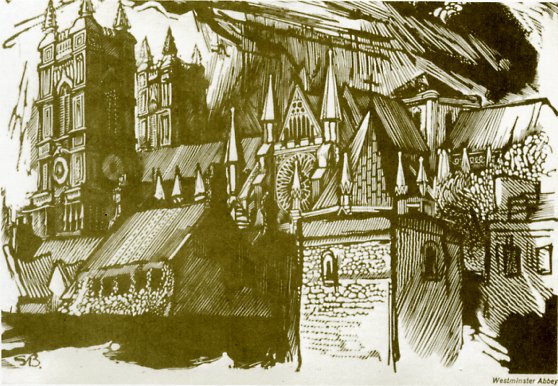
Under the heading “St. Edward’s, King and Confessor,” was this item of special interest about the school colors:
We recognize Saint Edward, King and Confessor, during the celebration of the 900th anniversary of the foundation of Westminster Abbey by our patron saint on Holy Innocents’ Day, 1065. Father Edward Sorin, founder of Notre Dame and St. Edward’s Universities, held King Edward as his patron saint. Blue and gold, the royal colors of the king, are the colors held dear by the two educational institutions. The death of Saint Edward is commemorated on October 13, his feast day. This day has been celebrated at Saint Edward’s University since the founding of our university in 1881, Austin, Texas.
In the midst of combing the Hesburgh Library stacks for more information about St. Edward, I made a startling discovery. A very bizarre story written about St. Edward the Confessor in 1688. Just touching a book written by someone in 1688 -- hidden away in the library stacks -- amazed me. I wondered how long it had been there without anyone laying a finger on it. The title covered the whole five inch by seven inch front cover of the book and read:
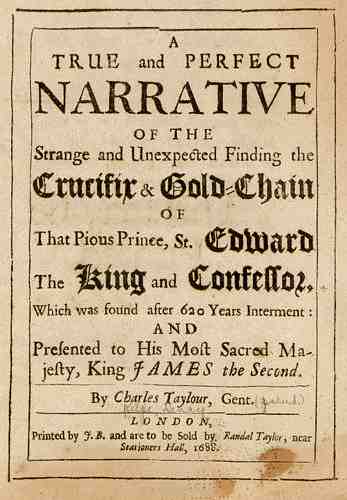
The ancient abbey and its history held a fascination for him. In observing renovations in the St. Edward’s Chapel at Westminster, after the workmen had left, he climbed a ladder to get a closer look at St. Edward’s tomb and noticed a hole in the top of it. Curious he reached into the hole and his fingers entwined around something inside. He carefully lifted it out to find it was the crucifix and Gold Chain of St. Edward
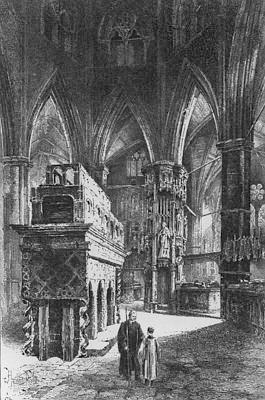
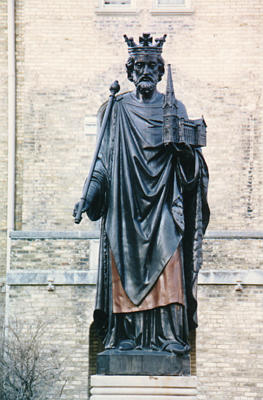
the Confessor. As one can imagine he pondered what to do next. If he put it back a curious workman might find it as he did and spirit it away. He decided to keep it safe from harm himself until he found someone in authority to pass it on to. His narrative relates his adventure in seeing it safely into the hands of King James himself. It’s a delightful story of an ordinary townsman finding himself, by chance circumstances, in the august presence of the King of England.
I immediately put this precious document into the hands of the Hesburgh Library Rare Books & Special Collections for safekeeping, whereby I learned it is one of only three copies in the world -- one in London, one at Harvard, and one at the University of Notre Dame. And it is there today for anyone interested to see for themselves. They made photocopies of the book for me in appreciation for seeing it into their hands. These copies are now with my research materials in the archives.
For those who would like to read Charles Taylour’s account of his adventure in his own words, click on Crucifix and Gold Chain for more photographs and a complete transcription of his booklet. By curious coincidence, a link with the past had been forged and in so doing a little known aspect of Notre Dame’s history had come to light.
The University’s Gold and Blue colors were not only associated with Mary, the Queen of Heaven, Father Sorin’s “guiding star,” they were also the royal colors of King Edward, St. Edward the Confessor, the patron saint of Father Edward Sorin -- founder of Notre Dame and St. Edward’s University. Father McAvoy said it so well: “To have a history is to have a name and the richer the history the more glorious the name.”
Earlier I found myself absorbed in the symbolism of stone and its application to the Grotto. Now I found the symbolism of color equally applicable. As the yellow flame on a lighted candle -- like hands folded in prayer -- is a symbol of hope, Mary is the ultimate symbol of faith and fidelity. Our lives, much more than we are aware of, are ordered by unconscious symbols that affect us subliminally, for good or ill, depending upon our personal perception of them. An interesting phenomenon to ponder, the tangible and intangible images stored away in our minds that have the power to spur us on, often against seemingly impossible odds.
A recent article in our local newspaper illustrates how our lives can be guided and sustained by symbolic inspirations. The news article reported:
The estate of Mary Frances McNamara gave $1.2 million to establish the McNamara Scholarship Fund in the Notre Dame Law School. A Chicago Public Schools teacher who died last year at age 99, McNamara wrote in her last will and testament, ‘Through my lifelong devotion to Mary Our Mother, I have been blessed with a long productive and happy life. . . . In thanksgiving, I bequeath all of the rest, residue and remainder of my estate . . . to her university, the University of Notre Dame du Lac . . . for the purpose of establishing more funded scholarships in the Law School.’(200)
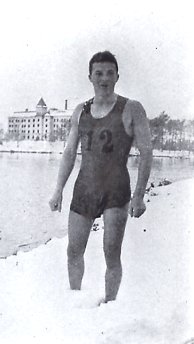
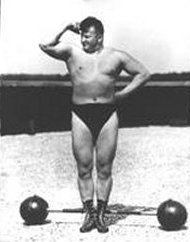
By now, I had become accustomed to the discovery of unusual archival finds in unexpected places. I decided to page through the remaining two Tower yearbooks before passing them on -- surprised to find in the next book a picture of a grotto at St. Edward’s. Curious, I decided to learn more about it. The material their archivist sent to me contained not only another of those long forgotten pieces of history but yet another item of interest the two universities shared in common.
The St. Edward’s Lourdes Grotto was designed and built in 1930-1933 by another Notre Dame legend, Fr. Bernard Lange, C.S.C., while he was at St. Edward’s earning an advance degree, a PH.D. in biology at St Edward’s University in Austin, Texas.
He was assisted in building the Grotto St. Edward’s by James Farraghar, a former Notre Dame grid star who was working at St. Edward’s at the time. They labored together over a span of two years to complete it. Fr. Lange was transferred back to Notre Dame, shortly after it was finished. It was not landscaped and accessorized until its dedication in 1939.
Except for his brief stay at St. Edward’s, Fr. Lange spent almost his entire lifetime at Notre Dame. Yet I found nothing in sources on the Notre Dame campus about St. Edward’s Grotto among the many stories written about Fr. Lange. He was a multi-talented man, an artisan with wood, a craftsman, whose colorful personality, and feats of daring bordered on the unbelievable.
An example of Fr. Lange’s almost unbelievable craftsmanship appeared in the April 1930 issue [p. 231] of Notre Dame Alumnus attesting to the fact that he was definitely a remarkable man. Fr. George MacNamara describes another one of Fr. Lange’s talents in a letter to the editor:
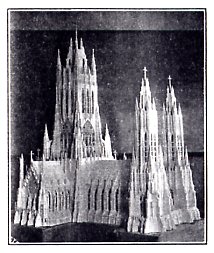 I feel sure that you and many of the old boys will be interested in the enthusiastic attention that is at present centered around our old friend, Father Bernard Lange, notorious in the old days as a football player, and noted more recently as a rector and as a scientist. Father Lange has created a perfect specimen of French Gothic architecture that is attracting the attention of architects and art students; he has built, in his leisure moments, a Gothic cathedral that is perfect in every detail and wonderfully beautiful in its grace, symmetry, and perfection. It is a thing of beauty, and its accuracy, even to the minutest detail has won admiration of all who have seen it. The model is a working model, built exactly to scale. One inch represents six feet. The height of the main tower, in the model is exactly eight feet to the top of the cross. That means that the church, if built to a six times scale, would tower 576 feet into the air....
I feel sure that you and many of the old boys will be interested in the enthusiastic attention that is at present centered around our old friend, Father Bernard Lange, notorious in the old days as a football player, and noted more recently as a rector and as a scientist. Father Lange has created a perfect specimen of French Gothic architecture that is attracting the attention of architects and art students; he has built, in his leisure moments, a Gothic cathedral that is perfect in every detail and wonderfully beautiful in its grace, symmetry, and perfection. It is a thing of beauty, and its accuracy, even to the minutest detail has won admiration of all who have seen it. The model is a working model, built exactly to scale. One inch represents six feet. The height of the main tower, in the model is exactly eight feet to the top of the cross. That means that the church, if built to a six times scale, would tower 576 feet into the air....
The model is so complete that even the windows, perfect imitations of stained glass, original designs, are complete in every detail. The windows are made of paper; the designs are drawings made by Father Lange, who used ink and water-color to give the stained glass effect. He has after the fashion of medieval glass workers, represented various members of the Holy Cross Community in some of these windows, and he has introduced the symbolic designs so much in vogue in true church decorations. At night, the church is lighted and a very pleasing and realistic effect is obtained when the lights of the model are turned on.
There are four large, and very beautiful, rose windows, each six inches in diameter, or thirty-six feet in diameter, if built according to scale. The large nave and wing windows, of which there are forty-two in the model, are two and one-half by nine inches. These would be fifteen by fifty-four feet in a completed church.
Father Lange was graduated from Notre Dame with a Litt.B. degree in 1912. In 1924 he received his M.A., and in 1926, his Sc.B. He is at present preparing for his Doctor’s degree. This model is a gem and we are all proud to stand around and listen to the comments of those who recognize real artistic work. They all marvel that he was able to produce such a perfect piece of art with the limited means at his disposal. The papers have been lavish in their comments and one professor in the University of Texas spent an hour explaining to his class the beauties and the perfection of Father Lange’s work of art built by a Notre Dame man.
In 1987, in the Notre Dame Magazine Dr. Paul Gill '70 said this about Father Lange the holder of the title of the fourth strongest man in the world:
His reputation as a non-conformist and superman dates to his years in Notre Dame Preparatory School. It was probably born the day he climbed to the top of the Golden Dome, wrapped his right arm around Our Lady, and waved to his awestruck classmates on the ground far below. The police were summoned, and he led them on a frantic chase through St. Ed’s Hall and down to St. Mary’s Lake, where he made good his escape by swimming under the ice to the far shore, where he broke from the lake headfirst and disappeared into the woods.
As Father Lange put it, “He almost got kicked out of school.” He would grease his body and swim in the icy waters of St. Mary’s Lake in the wintertime. His body building gym for Notre Dame boys and the stories told about him are legend.
 And once again, another coincidence, Father Lange, and the benefactor of the Our Lady of Lourdes Grotto at Notre Dame, Father Thomas Carroll, both came from Oil City, PA. Could the Notre Dame Grotto and its benefactor being from his hometown have inspired him to build the Grotto at St. Edward’s, or was it just a coincidence?
And once again, another coincidence, Father Lange, and the benefactor of the Our Lady of Lourdes Grotto at Notre Dame, Father Thomas Carroll, both came from Oil City, PA. Could the Notre Dame Grotto and its benefactor being from his hometown have inspired him to build the Grotto at St. Edward’s, or was it just a coincidence?
When I received the information about their Grotto from their archivist, Ingrid Karklins, as fate would have it, our son was living and working in Austin for a brief time. And thereby, I discovered another little piece of history associated with Sorin and another historic tree. On our one and only visit to see our son before he moved on, he took me to see the St. Edward’s Grotto, which is nestled in a little cliff below the Main Building on the highly elevated campus overlooking the city of Austin. As we climbed back up the high hill leading to a roadway above the Grotto, a burst of color flew past us from a bush nearby. It looked like a tropical bird loose from its cage. Intrigued, we both scurried after it just in time to see it land briefly in a huge live oak tree near the Main Building. When it flew away, I began admiring the impressive tree before us, my eyes drawn to a plaque beneath it. Written on it were the words, “Sorin’s Tree.”
To my wonderment a colorful bird on the wing had led us to that very tree and another interesting piece of history. A call to the archivist solved two mysteries. She said the colorful bird was a Monk parrot, that many had migrated from South America and made their home in Austin. She also supplied additional information I hadn’t run across before. When Sorin founded St. Edward’s University in Austin, Texas, he expressed the wish that it would become the “Notre Dame of the South.” The tree I saw was called “Sorin’s Tree” because he chose the site for its hilltop view and the huge live oak growing there. It also became known as the “Umbrella Tree” and the “Lone Tree” because it was the only tree on the spot at the time. I could not help but wonder if Sorin might have chosen to build St. Edward’s Main Building near its historic tree because of Notre Dame’s legendary landmark sycamore.
Learning more about Sorin and the St. Edward’s University proved to be another of those interesting unplanned detours I would never have expected to take and it provided more tidbits of information that were just too tempting and out-of-the-ordinary to resist. The prospect of learning more about Mary’s school colors and Notre Dame’s own landmark tree -- was more than enough to spur me on.
The name chosen for the University, Notre Dame du Lac (Our Lady of the Lake) spoke for itself. Even the island in the original “one” lake, until it became two, was known as St. Mary’s Island. Both campuses, Notre Dame and Saint Mary’s, and everything on them -- buildings, grounds, the lake, the Grotto, the Ave Maria magazine and the school colors -- were dedicated to the Blessed Virgin.